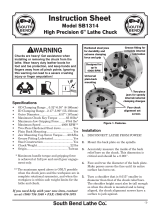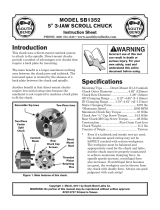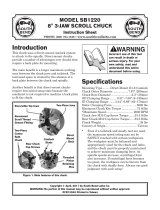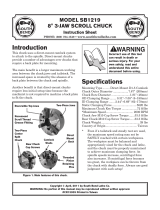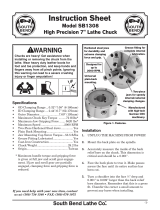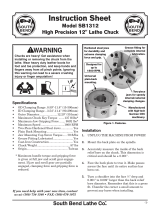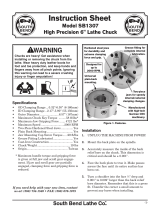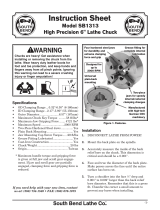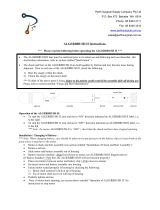Page is loading ...

Scroll gear design
provides single
chuck key
control of
all jaws
Specifications
• OD Clamping .................. 0.16"–7" (4–180mm)
• ID Clamping ............ 2.20"–6.69" (56–170mm)
• Chuck Bore Diameter ................2.28" (58mm)
• Chuck Outer Diameter ............7.60" (193mm)
• Front Mounting Cap Screw Torque ...29 ft/lbs
• Rear Mounting Hex Bolt Torque ........53 ft/lbs
• Maximum Chuck Key Torque ............72 ft/lbs
• Maximum Gripping Force (at Full Jaw and
Scroll Gear Tooth Engagement) .....5620 ft/lbs
• Maximum Speed ...........................2000 RPM*
• Mounting Type ............. Universal Plain Back
• Construction ..................Fine-Grain Cast-Iron
• ChuckWeight ......................................... 33 lbs
• Country of Origin ................................ Taiwan
Installation
1. DISCONNECTLATHEFROMPOWER!
2. Mount the back plate on the spindle.
3. Accurately measure the inside of the back
relief bore on the chuck. This dimension is
critical and should be ± 0.001''.
4. Face the entire surface of the back plate.
5. Turn a shoulder into the back plate face that
is
1
⁄8'' deep and 0.001" to 0.002'' larger than
the relief bore that is on the mounting side of
the chuck. (Remember, a press fit must exist
between the two.) Slightly chamfer the edges
to prevent any burrs when installing.
Hardened steel jaws
for durability and
extreme clamping
force and grip
Universal plain-
back mounting
Manufactured
with high-tech
German CNC
machinery
Fine-grain cast
iron body
Front or rear
mounting
bolt pattern
* The maximum speed listed above is ONLY
possible with the chuck jaws and the
workpiece in complete rotational symmetry.
The workpiece weight must be within the
limits of the lathe, and the workpiece mass
must be of equal density throughout to
prevent centrifugal imbalance or radial
runout—even if a tailstock or other support
is used for additional support.
Instruction Sheet
PHONE: (360) 734-1540 • www.southbendlathe.com
MODEL SB1234
7" 4-JAW SCROLL CHUCK
Copyright © November, 2010 by South Bend Lathe Co.
WARNING: No portion of this manual may be reproduced without written approval.
#CR13312 Printed in Taiwan
Chucks are heavy! Get assistance when
installing or removing the chuck from the
lathe. Wear heavy duty leather boots for
foot and toe protection, and keep hands and
fingers away from all pinch points. Ignoring
this warning can lead to a severe crushing
injury or finger amputation!

6. Set the chuck on the back plate, and align
the shoulder with the relief bore. Use a
transfer punch to mark the mounting holes
in the back plate. Or you can use a drill bit
of the same diameter as the mounting holes
in the chuck. Lightly tap on the bit, rotate it
90°, and tap it again to form an X.
7. Remove the back plate from the lathe, drill
the chuck mounting cap screw holes though
the back plate, and then tap the holes.
8. Clean and stone all mating surfaces until
they are perfectly clean and free of burrs.
9. Place the back plate into a freezer for 30
minutes; place the chuck in an oven at 100°F
for the same amount of time.
10. Put on insulated leather gloves and fasten
the chuck to the back plate with the
mounting cap screws only finger tight, then
install the assembly onto the lathe spindle.
11. Tighten the chuck mounting cap screws in
a star pattern in three progressively tighter
sequences until you reach a final torque of
29 ft/lbs. Alternating the tightening process
insures the chuck will be pressed on straight.
Repeat this step until the chuck seats with
back plate.
If the chuck is loose, or is crooked on the
shoulder, it will be necessary to recut the
back plate face and shoulder again.
If you are also installing the chuck by
threading the hex bolts into the chuck from
the back side of the mounting plate, repeat
Step 11 on these bolts, but torque them to
53 ft/lbs.
12. Wheninstallationiscomplete,lightlystamp
alignment marks in the chuck and back plate
to ensure that the chuck will be re-installed
in the same position if ever removed.
Safety
• Chuck Key Safety: A chuck key left in the
chuck can become a dangerous projectile
when the spindle is started. Always remove
the chuck key after using it. Develop a habit
of not taking your hand off of a chuck key
unless it is away from the machine.
•
Disconnect Power: Disconnect the lathe
from power before installing and removing
the chuck or doing any maintenance or
adjustments. Accidental lathe startup can
cause severe injury or death.
•
Secure Clamping: A thrown workpiece
may cause severe injury or even death.
Whenswappingthechuckjawpositions,
keep in mind that maximum gripping
force is attained at full jaw and jaw screw
engagement. If only one is partially engaged,
overall clamping force is reduced.
•
Speed Rates: Operating the lathe where
maximum chuck speed is exceeded, or at too
high of a speed for an unbalanced workpiece,
can cause the workpiece to be thrown from
the chuck. Always use the appropriate feed
and speed rates. A thrown workpiece may
cause severe injury or even death.
•
Large Chucks: Large chucks are very
heavy and difficult to grasp, which can lead
to crushed fingers or hands if mishandled.
Get assistance when installing or removing
large chucks to reduce this risk. Protect your
hands and the precision ground ways by
using a chuck cradle or piece of plywood over
the ways of the lathe when servicing chucks.
•
Safe Clearances: Often chuck jaws will
protrude past the diameter of the chuck and
can contact a coolant nozzle, tooling, tool
post, or saddle. Before starting the spindle,
make sure the workpiece and the chuck
jaws have adequate clearance by rotating it
through its entire range of motion by hand.
-2-
Mfg. Since 5/10
Model SB1236
INSTRUCTIONS

Figure 1. Chuck sequence of disassembly.
Care & Maintenance
For optimum performance from your chuck,
follow the maintenance schedule below. Never
hammer on the chuck, jaws, or a workpiece that
is clamped in the chuck; and never subject the
chuck to abrasives, flame, or water.
Daily:
• Check/correctloosemountingbolts.
• Keep the chuck clean and oiled.
• Use a vacuum, rag, or brush to clean the
chuck after use. Never use air pressure to
clean chips away from a chuck.
• Avoidleavingthechuckclampedona
workpiece, unload the chuck jaws daily.
• Makesurethechuckkeyisremovedfrom
the chuck when not in use.
If the chuck ever becomes stiff to operate, it may
have been contaminated with metal chips or
abrasives from incorrect or limited maintenance
intervals. If this is the case, the chuck must be
disassembled, cleaned, and re-lubricated.
To disassemble the chuck for a full cleaning
and lubrication service:
1. DISCONNECTLATHEFROMPOWER!
2. Unbolt and remove the chuck. Unless
previously done, stamp alignment marks in
the chuck and the mounting plate to ensure
that they line up when reassembled.
3. Disassemble the chuck in the alphabetical
sequence shown in Figure 1.
a. Back the jaws out of the chuck, and
remove the grease fitting.
b. Unthread and remove the pinion
retaining screw.
Always disconnect
machine from power before
performing maintenance or
serious personal injury may
result.
!
c. Remove the pinion.
d. Remove the chuck backing plate screws
and the back plate.
e. Remove the scroll gear from the inside of
the chuck bore.
4. Using mineral spirits, clean and dry all
components. Inspect all bores, teeth, pins,
and mating surfaces for wear, burrs, galling,
rust, or cracks, and re-dress as required.
5. Coat all parts with any automotive NLGI #2
grease, and carefully reassemble the chuck
in the reverse order shown in Figure 1.
6. Rotate the chuck key clockwise until you
see the tip of the scroll-gear lead thread just
begin to enter jaw guide #1.
7. Insert jaw #1 into jaw guide #1, and hold the
jaw against the scroll-gear.
8. Rotate the chuck key clockwise one turn to
engage the tip of the scroll-gear lead thread
into the jaw. Pull the jaw; it should be locked
into the jaw guide.
9. Install the other jaws in the same manner,
and install a new grease fitting.
10. Starting at Step 8 in Chuck Installation
on Page 2, align and re-install the chuck as
outlined.
a
b
c
e
d
Note: Each jaw is marked
1, 2, or 3 to correspond
to its marked slot in the
chuck
Mfg. Since 5/10 Model SB1236
-3-
INSTRUCTIONS

Parts ListParts Diagram
Please Note: We included this parts breakdown for service purposes only. Since many of the parts shown are machined to
each individual chuck, they may not be available as replacement items.
REF PART # DESCRIPTION
1 PSB1234001 GREASE FITTING
2 PSB1234002 INTERNAL JAW SET OF 4
3 PCAP115M BUTTON HD CAP SCR M6-1 X 16
4 PSB1234004 BACK COVER
5 PSB1234005 LOCK PIN
6 PSB1234006 PINION
7 PSB1234007 SCROLL GEAR
8 PSB1234008 CHUCK KEY
9 PCAP171M CAP SCREW M10-1.5 X 80 BLK C12.9
10 PSB1234010 EXTERNAL JAW SET OF 4
11 PSB1234011 CHUCK BODY
12 PB174M HEX BOLT M10-1.5 X 35 BLK C12.9
Troubleshooting
Symptom Possible Cause Possible Solution
The chuck has
hard spots or binds
completely.
1.
Jaw is in a poor position for
clamping.
1.
Re-install jaws in correct order and position on
scroll gear.
2.
Lack of lubrication, rust, burr, or
metal shavings inside of chuck.
2.
Disassemble, de-burr, clean, and lubricate chuck.
3.
Broken tooth on the jaw or the jaw
screw.
3.
Disassemble and rebuild chuck.
Clamping accuracy
is poor.
1.
Workpieceimproperlyclampedor
workpiece is misaligned.
1.
Remove jaws, clean, de-burr, and re-install, verify
accuracy and recalibrate test/dial indicator.
2.
Chuck loose, mounting is off center,
or it is improperly seated.
2.
Remove chuck, clean and de-burr mounting, and re-
install, or machine a new mounting plate.
The workpiece slips
in the jaws.
1.
Incorrect jaw or workpiece clamping
position.
1.
Re-position jaws and workpiece for maximum scroll
gear and jaw engagement is achieved.
2.
Insufficient pinion and scroll gear
torque.
2.
Tighten chuck key to 72 ft/lbs.
3.
Chuck is binding before full
clamping force is achieved, or a jaw
or jaw screw is binding.
3.
Chuck is loaded up with contaminants causing
binding. Disassemble and service chuck. Loosen
and retighten the chuck key several times to work
lubricant in.
4.
Cutting overload.
4.
Reduce cutting depth or feed rate.
6
8
9
2
11
12
5
7
4
3
1
10
If you need help with your new chuck,
contact us at:
PHONE: (360) 734-1540
FAX: (360) 676-1075 (International)
FAX: (360) 734-1639 (USA Only)
EMAIL: [email protected]
-4-
Mfg. Since 5/10
Model SB1236
INSTRUCTIONS
/
